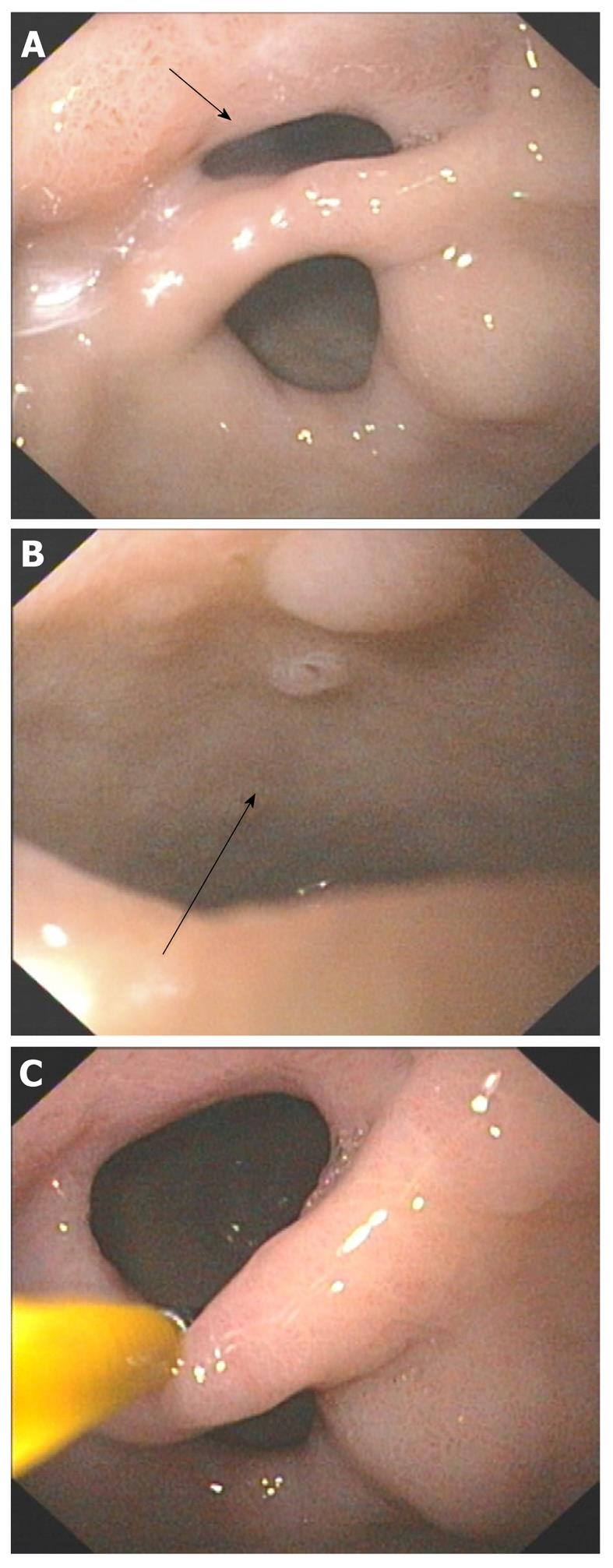Published online Mar 16, 2012. doi: 10.4253/wjge.v4.i3.94
Revised: November 29, 2011
Accepted: March 2, 2012
Published online: March 16, 2012
Acquired double pylorus (DP) is an uncommon condition consisting of two communicating channels between the gastric antrum and the first part of duodedum. Little is known about the origin of DP. As there is no specific gastrointestinal symptom due to DP, most often it is diagnosed by gastroscopy while performing for other indicationsFew data are also known about the clinical course of DP. In the patients with peptic ulcer symptoms, the pyloroplasty-like drainage effect, improving gastric emptying after the estabilishment of the fistula, could relieve these symptoms. This represents an unresolved issues about the necessity of repeating endoscopy to document in the patients with DP its final outcome, as the risk of ulcer recurrence. We describe a case of a 76-years-old woman admitted to our department for hyposideremic anemia associated to a recent history of melena.
- Citation: Linea C, Sinagra E, La Seta F, Giunta M. Acquired double pylorus, due to penetrating gastric ulcer, presenting with melena. World J Gastrointest Endosc 2012; 4(3): 94-95
- URL: https://www.wjgnet.com/1948-5190/full/v4/i3/94.htm
- DOI: https://dx.doi.org/10.4253/wjge.v4.i3.94
Acquired double pylorus (DP) is an uncommon condition (less than 0.4% of gastroscopies)[1,2] consisting of two communicating channels between the gastric antrum and the first part of duodedum. It represents often an incidental finding at the upper endoscopy, when this is performed for other indications[3], and because of its rarity few data are available about its clinical course and consequently about the way to follow up this endoscopical entity. We describe a case of a 76-years-old woman with hyposideremic anemia, associated to a recent history of melena, in which an upper endoscopy showed an acquired double pylorus, due to penetrating gastric ulcer.
We describe a case of a 76-years-old woman admitted to our department for hyposideremic anemia (Hb 5 g%) associated to a recent history of melena. A gastroscopy was performed, showing a fistula, into the antral superior wall, between the prepyloric antrum and the duodenal bulb, with hyperaemic stigmata into the mucosa associated with scarred sign, typical of past penetrating ulcer (Figure 1). Hystology of the antrum showed the features of mild chronic erosive gastritis Helicobacter pylori (HP) positive. Upper gastrointestinal series were performed, but they were not diagnostic because repeated vomiting of the patient during the exam; despite they did not confirm the presence of a DP, the visualization of an eccentric pylorus could be compatible with the gastro-duodenal fistula seen at the gastroscopy (Figure 2). A colonoscopy did not show any source of bleeding. After three blood transfusions, the patient was discharged with a triplex HP eradication therapy and a procinetic, with disappearance of melena and improvement of Hemoglobin value (10 g %). Urea breath test was performed one month later, showing the eradication of HP infection. Normal haemoglobin levels and the absence of gastrointestinal symptoms were noted on follow-up.
Little is known about the origin of DP. As there is no specific gastrointestinal symptom due to DP, most often it is diagnosed by gastroscopy while performing for other indications[3]. The radiological features are characteristic: there are two channels connecting the gastric antrum to the superior fornix of the duodenal bulb, while the fistula usually arises from the lesser curvature of the antrum. Despite this, it is sometimes difficult to distinguish between double pylorus and marked pyloric deformity[4]. Association with HP has been observed in other case report series[5,6], while other authors reported that double pylorus could be an extremely uncommon presentation of gastric adenocarcinoma[7].
Few data are also known about the clinical course of DP. In the patients with peptic ulcer symptoms, the pyloroplasty-like drainage effect, improving gastric emptying after the estabilishment of the fistula, could relieve these symptoms[4]. Hu et al[2] noted that majority of the cases of DP treated with eradication therapy for HP remained open. This represents an unresolved issues about the necessity of repeating endoscopy to document in the patients with DP its final outcome, as the risk of ulcer recurrence.
Peer reviewer: Shotaro Enomoto, MD, PhD, Second Department of Internal Medicine, Wakayama Medical University, 811-1, Kimiidera, Wakayama 641-0012, Japan
S- Editor Yang XC L- Editor A E- Editor Yang XC
| 1. | Wiseman SM, Tan D, Hill HC. Double pylorus: an unusual endoscopic finding. Endoscopy. 2005;37:277. [RCA] [PubMed] [DOI] [Full Text] [Cited by in Crossref: 8] [Cited by in RCA: 9] [Article Influence: 0.5] [Reference Citation Analysis (0)] |
| 2. | Hu TH, Tsai TL, Hsu CC, Lu SN, Hsiao M, Changchien CS. Clinical characteristics of double pylorus. Gastrointest Endosc. 2001;54:464-470. [RCA] [PubMed] [DOI] [Full Text] [Cited by in Crossref: 23] [Cited by in RCA: 25] [Article Influence: 1.0] [Reference Citation Analysis (0)] |
| 3. | Varghese J, Balakrishnan V, Nair P Narayanan VA. Surgery Journal. 2010;5:7-8. [RCA] [DOI] [Full Text] [Cited by in Crossref: 1] [Cited by in RCA: 1] [Article Influence: 0.1] [Reference Citation Analysis (0)] |
| 4. | Kwan HK, Yeung WH, Chan TM, Cheng CS. Double Pylorus with Occult Gastrointestinal Bleeding. J HK Coll Radiol. 2001;4:157-159. |
| 5. | Akazawa Y, Mizuta Y, Osabe M, Nakamura T, Morikawa S, Isomoto H, Takeshima F, Kohno S, Murata I. A case of double pylorus caused by recurrent gastric ulcers: a long-term endoscopic observation. Dig Dis Sci. 2005;50:2125-2128. [RCA] [PubMed] [DOI] [Full Text] [Cited by in Crossref: 7] [Cited by in RCA: 8] [Article Influence: 0.4] [Reference Citation Analysis (0)] |
| 6. | Safatle-Ribeiro AV, Ribeiro Junior U, Habr Gama A, Gama Rodriguez JJ. Double pylorus: case report and review of the literature. Rev Hosp Clin Fac Med Sao Paulo. 1999;54:131-134. [RCA] [DOI] [Full Text] [Cited by in Crossref: 10] [Cited by in RCA: 14] [Article Influence: 0.5] [Reference Citation Analysis (0)] |
| 7. | Fine M, Kavin H, Grant T. Double-channel pylorus as a complication of carcinoma of the stomach. Gastrointest Endoscop. 1987;33:39-41. |










